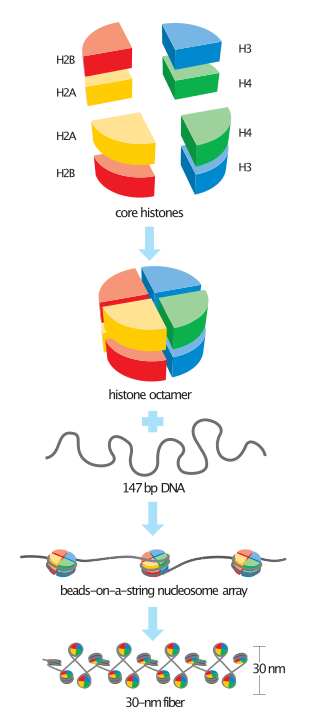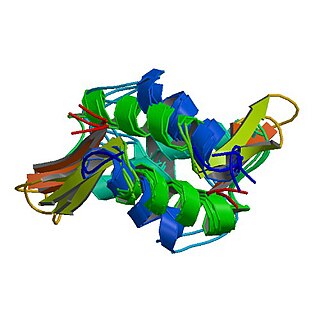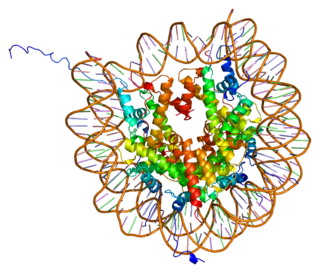Related Research Articles
Chromatin is a complex of DNA and protein found in eukaryotic cells. The primary function is to package long DNA molecules into more compact, denser structures. This prevents the strands from becoming tangled and also plays important roles in reinforcing the DNA during cell division, preventing DNA damage, and regulating gene expression and DNA replication. During mitosis and meiosis, chromatin facilitates proper segregation of the chromosomes in anaphase; the characteristic shapes of chromosomes visible during this stage are the result of DNA being coiled into highly condensed chromatin.

A nucleosome is the basic structural unit of DNA packaging in eukaryotes. The structure of a nucleosome consists of a segment of DNA wound around eight histone proteins and resembles thread wrapped around a spool. The nucleosome is the fundamental subunit of chromatin. Each nucleosome is composed of a little less than two turns of DNA wrapped around a set of eight proteins called histones, which are known as a histone octamer. Each histone octamer is composed of two copies each of the histone proteins H2A, H2B, H3, and H4.

Histone acetyltransferases (HATs) are enzymes that acetylate conserved lysine amino acids on histone proteins by transferring an acetyl group from acetyl-CoA to form ε-N-acetyllysine. DNA is wrapped around histones, and, by transferring an acetyl group to the histones, genes can be turned on and off. In general, histone acetylation increases gene expression.

DNA-binding proteins are proteins that have DNA-binding domains and thus have a specific or general affinity for single- or double-stranded DNA. Sequence-specific DNA-binding proteins generally interact with the major groove of B-DNA, because it exposes more functional groups that identify a base pair.
HMGN proteins are members of the broader class of high mobility group (HMG) chromosomal proteins that are involved in regulation of transcription, replication, recombination, and DNA repair.

Histone H1 is one of the five main histone protein families which are components of chromatin in eukaryotic cells. Though highly conserved, it is nevertheless the most variable histone in sequence across species.
High-Mobility Group or HMG is a group of chromosomal proteins that are involved in the regulation of DNA-dependent processes such as transcription, replication, recombination, and DNA repair.

Transcriptional repressor CTCF also known as 11-zinc finger protein or CCCTC-binding factor is a transcription factor that in humans is encoded by the CTCF gene. CTCF is involved in many cellular processes, including transcriptional regulation, insulator activity, V(D)J recombination and regulation of chromatin architecture.
Chromatin remodeling is the dynamic modification of chromatin architecture to allow access of condensed genomic DNA to the regulatory transcription machinery proteins, and thereby control gene expression. Such remodeling is principally carried out by 1) covalent histone modifications by specific enzymes, e.g., histone acetyltransferases (HATs), deacetylases, methyltransferases, and kinases, and 2) ATP-dependent chromatin remodeling complexes which either move, eject or restructure nucleosomes. Besides actively regulating gene expression, dynamic remodeling of chromatin imparts an epigenetic regulatory role in several key biological processes, egg cells DNA replication and repair; apoptosis; chromosome segregation as well as development and pluripotency. Aberrations in chromatin remodeling proteins are found to be associated with human diseases, including cancer. Targeting chromatin remodeling pathways is currently evolving as a major therapeutic strategy in the treatment of several cancers.

Histone H3.1t is a protein that in humans is encoded by the HIST3H3 gene.

Methyl-CpG-binding domain protein 2 is a protein that in humans is encoded by the MBD2 gene.

FACT complex subunit SSRP1 also known as structure specific recognition protein 1 is a protein that in humans is encoded by the SSRP1 gene.

Non-histone chromosomal protein HMG-14 is a protein that in humans is encoded by the HMGN1 gene.

Histone H2B type 3-B is a protein that in humans is encoded by the HIST3H2BB gene.

Histone H1.1 is a protein that in humans is encoded by the HIST1H1A gene.

Non-histone chromosomal protein HMG-17 is a protein that in humans is encoded by the HMGN2 gene.

Histone H2A type 2-B is a protein that in humans is encoded by the HIST2H2AB gene.

High mobility group nucleosome-binding domain-containing protein 3 is a protein that in humans is encoded by the HMGN3 gene.

In molecular biology, the HMG-box is a protein domain which is involved in DNA binding. The domain is composed of approximately 75 amino acid residues that collectively mediate the DNA-binding of chromatin-associated high-mobility group proteins. HMG-boxes are present in many transcription factors and chromatin-remodeling complexes, where they can mediate non-sequence or sequence-specific DNA binding.

High mobility group nucleosome-binding domain-containing protein 4 is a transcription factor that in humans is encoded by the HMGN4 gene.
References
- ↑ Dodgson JB, Browne DL, Black AJ (1988). "Chicken chromosomal protein HMG-14 and HMG-17 cDNA clones: isolation, characterization and sequence comparison". Gene. 63 (2): 287–295. doi:10.1016/0378-1119(88)90532-X. PMID 3384337.
- ↑ Gonzalez FJ, Bustin M, Landsman D, Soares N (1986). "Chromosomal protein HMG-17. Complete human cDNA sequence and evidence for a multigene family". J. Biol. Chem. 261 (16): 7479–7484. PMID 3754870.
- ↑ Bustin M, Landsman D, Shirakawa H, Postnikov YV (2000). "NBP-45, a novel nucleosomal binding protein with a tissue-specific and developmentally regulated expression". J. Biol. Chem. 275 (9): 6368–6374. doi: 10.1074/jbc.275.9.6368 . PMID 10692437.